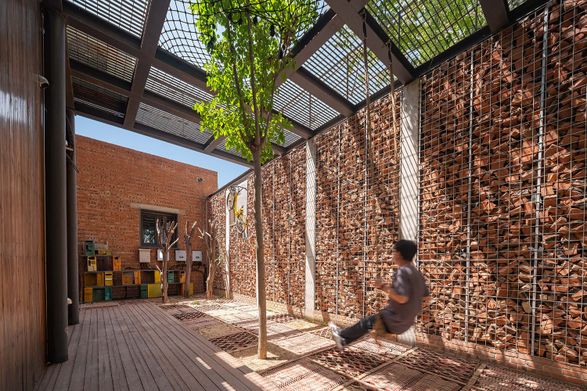CONSTRUCTION MANAGEMENT
China Construction No.6 Bureau
PROJECT MANAGEMENT
Baojun Zhang, Xiaotao Lu, Linchong Hao, Rongyan Xiao
DESIGN TEAM
Jun Ren, Runbo Guo, Yang Di, Nan Jiang
MANUFACTURERS
Hanergy Photovoltaic
PROJECT PLANNING
School of Architecture Tianjin University, Tenio Architecture and Engineering Co.Ltd.
EQUIPMENT ENGINEER
Bing Liu, Shuai Han, Wei Liu
PHOTOGRAPHS
AWESOME, Jun Ren
AREA
400 m²
YEAR
2021
LOCATION
Beijing, China
CATEGORY
Houses, Renovation
This village project in the suburbs of Beijing focuses on the problem of indigenous resident loss in rural areas of China.
The overall goal is to improve residential comfortableness and realize energy self-sufficiency by means of green transformation, to introduce functions such as creative office, and to realize function conversion and rural revival.
The main goal of the project is to explore the technical possibilities and construction realizability of assembled nearly zero energy rural house reconstruction.
The approach to this goal is to respond to rural ecology and cold climate in a targeted manner, to use the technical strategy of the passive house to achieve minimum energy requirement, and to combine multiple new solar energy utilization methods to achieve nearly zero energy building.

Prefabricated modules are used for the added residential part, and are assembled on site.
PROCESS —— Nearly zero energy building in the rural area combining ultra-low energy consumption with modular assembly
The building has improved the nearly zero energy building space system that is suitable for the single-story courtyard layout.
The courtyard divides the building into three parts of simple shapes, and air-tightness units are connected with passive house and stairwell wind tower to enhance heat radiation in winter and guide the natural ventilation in transitional seasons.
The building is an experiment of low-cost assembled residential modules.
The composite model is consisting of a light steel system and OSB board, and two kinds of thermal insulation materials are filled inside and applied outside to ensure the system’s heat transfer coefficient and airtightness.
The standard residential modules from the structure to the interior decoration are completed in the factory, and three modules are combined to a residential unit of complete functions on site.
The sloping roof uses [ skylights to achieve natural lighting and uses photovoltaic tiles to provide electric energy.
The nearly zero-energy consumption during the operation phase can minimize the energy consumption and carbon emission arising from air conditioning, heating, and lighting.
During the production and construction phase, rustic materials and local constructors are used to reduce carbon emissions arising from transportation and construction.
Through these carbon reduction strategies, the annual carbon emission can be reduced by 7.6 tons.
The courtyard and building facade integrate advanced green technology, the book room gathers nearly a hundred books on sustainable buildings, and the exhibition hall shows the energy-saving and construction technologies of nearly zero-energy rural houses, making it a showcase and demonstration of the nearly zero energy rural house model.
PLANET —— Reducing ecological impact and realizing carbon-neutral building with net-zero energy consumption.
The building keeps the courtyard layout in the local culture and is designed as different green-themed courtyards.
The rural ecology and the tall poplars on the north and east sides of the plot are kept, and a ladder-shaped vegetable garden is designed in combination with the existing poplars and the green space at the village entrance.
Based on the ecological functions, the three courtyards are defined as different themed courtyards, respectively water courtyard, solar courtyard, and zero-carbon garden decorated with waste.
A greenhouse is set in the south courtyard, where a fish and vegetable symbiosis system composed of vertical hydroponic plants is arranged.






















